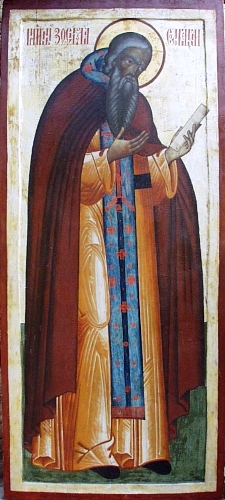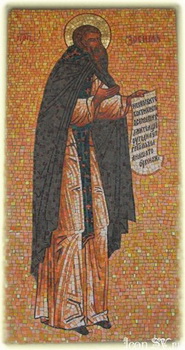
The Monk Zosima, Hegumen of Solovetsk, – a great luminary of the Russian North, was the founder of monastic common-life on Solovetsk Island. He was born in Novgorod diocese, in the village of Tolvui near Lake Onega. From his early years he was raised in piety, and after the death of his parents Gavriil and Varvara he gave away his possessions and accepted monastic tonsure.
In search of a solitary place the monk set off to the shores of the White Sea and at the mouth of the Suma he met the Monk German (Comm. 30 July), who told him about a desolate sea island, where formerly he had spent six years with the Monk Savvatii (Comm. 27 September).
In about the year 1436 the hermits, felicitously having made the sea voyage, landed at the Solovetsk islands. God blessed the place of their settlement with a vision to the Monk Zosima of a beautiful church in the sky. The monks with their own hands built cells and an enclosure, and they began to cultivate and sow the land. One time in late Autumn the Monk German set off to the mainland for necessary provisions. Because of the Autumn weather he was not able to return. The Monk Zosima remained all Winter alone on the island. He suffered many a temptation in struggle with the devils. Death by starvation threatened him, but miraculously two strangers having appeared left him a supply of bread, flour and oil. In Spring the Monk German returned to Solovetsk together with the fisherman Mark, and he brought supplies of food and rigging-tackle for fish nets.
When several hermits had gathered on the island, the Monk Zosima constructed for them a small wooden church in honour of the Transfiguration (Preobrazhenie) of the Lord, together with a refectory. At the request of the Monk Zosima, an hegumen was sent from Novgorod to the newly formed monastery with antimins for the church. Thus occurred the start of the reknown Solovetsk monastery. In the severe conditions of the remote island the monks knew how to arrange their economy. But the hegumens, sent from Novgorod to Solovetsk, could not withstand life in the unwontedly harsh conditions, and so the brethren chose as hegumen the Monk Zosima.
The Monk Zosima concerned himself with the building up of the inner life of the monastery, and he introduced a strict life-in-common. In 1465 he transferred to Solovetsk from the River Vyg the relics of the Monk Savvatii. The monastery suffered vexation from the Novgorod boyars (nobles), who confiscated catches of fish from the monks. The monk was obliged to set off for Novgorod and seek the protection of the archbishop. On the advice of the archbishop, he made the rounds of homes of the boyars and requested them not to allow the ruin of the monastery. The influential and rich boyarina Martha Boretskaya impiously gave orders to throw out the Monk Zosima, but then repented her action and invited him to a meal, during the time of which he suddenly beheld, that six of the illustrious boyars sat without their heads. The Monk Zosima told about this vision to his disciple Daniel and predicted for the boyars an immanent death. The prediction was fulfilled in the year 1478, when during the taking of Novgorod by Ivan III (1462-1505) the boyars were executed.
Shortly before death the monk prepared himself a grave, in which he was buried beyond the altar of the Transfiguration church (+ 17 April 1478). Later on, over his relics was built a chapel. His relics together with the relics of the Monk Savvatii were transferred on 8 August 1566 into a chapel consecrated in their memory at the Transfiguration cathedral.
Many a miracle was witnessed to, when the Monk Zosima with the Monk Savvatii appeared to fishermen perishing in the depths of the sea. The Monk Zosima is likewise a patron of bee-keeping and preserver of bee-hives, and to him is even bestown the title "Bee-keeper" ("Pchel'nik"). To the Monk Zosima often hasten those in sickness. The many hospital churches dedicated to him testify to the great curative power of his prayer before God.
 The Monk Zosima, Hegumen of Solovetsk, – a great luminary of the Russian North, was the founder of monastic common-life on Solovetsk Island. He was born in Novgorod diocese, in the village of Tolvui near Lake Onega. From his early years he was raised in piety, and after the death of his parents Gavriil and Varvara he gave away his possessions and accepted monastic tonsure.
The Monk Zosima, Hegumen of Solovetsk, – a great luminary of the Russian North, was the founder of monastic common-life on Solovetsk Island. He was born in Novgorod diocese, in the village of Tolvui near Lake Onega. From his early years he was raised in piety, and after the death of his parents Gavriil and Varvara he gave away his possessions and accepted monastic tonsure.
